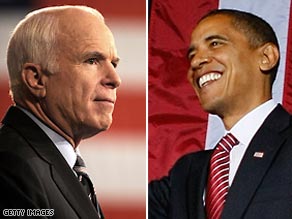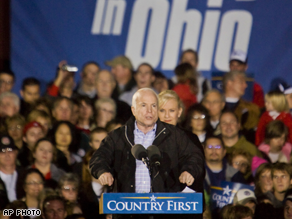The waning hours of the longest presidential campaign in history elicited a fresh round of stinging attacks from Sens. Barack Obama and John McCain and their supporters on Sunday, a departure from the positive messages that candidates normally revert to before an election.
The two candidates kept swinging at each other as their campaigns focused on a handful of states that will determine the election. Obama cut an ad that used Vice President Cheney's endorsement of McCain to reinforce his central argument that his rival represents a third term of the unpopular Bush administration.
Republicans in Pennsylvania brought back the controversial comments of Obama's former pastor, the Rev. Jeremiah A. Wright Jr., despite McCain's admonition that he should not be used as a political weapon, and the campaign unleashed robo-calls that employed the withering dismissal that Sen. Hillary Rodham Clinton made of Obama's experience when the two were competing against each other in the Democratic primaries.
McCain adviser Charlie Black said his candidate would have preferred that the Pennsylvania GOP not air the ad using Wright's controversial anti-American statements. But "as McCain said back in the spring, he can't be the referee of every ad," Black said.
Ending a campaign on a positive note, said Republican strategist Scott Reed, "may be part of the old way, but this is unlike any campaign we've ever seen. There is such a small slice of undecided out there, I think both sides are going to finish the campaign really going after them."
Those voters, according to polls, represent McCain's last, best hope. But his campaign manager, Rick Davis, made the rounds of the talk shows to forcefully rebut pollsters and pundits uniformly predicting an Obama victory. "I think what we're in for is a slam-bang finish," Davis said on "Fox News Sunday." "I mean, it's going to be wild. . . . John McCain may be the greatest closer politician of all time."
He will need to be. Even Davis acknowledged that McCain will probably need to walk a tightrope to put together enough states to eke out the 270 electoral votes needed for victory. To that end, McCain campaigned in two states leaning toward Obama, Pennsylvania and New Hampshire, that he hopes will provide part of the solution to that puzzle.
Obama's campaign architects said their sophisticated get-out-the-vote operation and months of organizing give the senator from Illinois multiple paths to victory. "Our number one strategic goal was to have a big playing field," Obama campaign manager David Plouffe said on the same morning show. "We did not want to wake up on the morning of November 4 waiting for one state. We wanted a lot of different ways to win this election."
The closing days' schedules served as a guide to the states that will loom large on the networks' maps Tuesday night: Ohio, Florida, Virginia, North Carolina, Pennsylvania, Indiana, New Mexico, Nevada.
Obama spent the entire day in Ohio, where voters have been going to the polls for weeks and a victory would be a back-breaker for his Republican rival. "Go vote right now," he told supporters at the Ohio Statehouse in Columbus, and his campaign aides expressed confidence that they are better organized than any Democrat in years to deliver the vote.
The Democratic nominee played to huge crowds in Columbus, Cincinnati and Cleveland, where he and his family were introduced by musician Bruce Springsteen. Campaign officials are confident that their ground game here is far more potent than the organization that Sen. John F. Kerry fielded four years ago, when he lost Ohio to President Bush by 51 percent to 49 percent. In 2000, Bush beat Al Gore by four percentage points.
As the electoral map shrinks in these final hours, Ohio has become a must-win for McCain. But if Obama succeeds here, it will avenge not only the Kerry and Gore defeats but also his loss to Clinton during the primary, a defeat that underscored Obama's struggles with working-class white voters.
'Politics' 카테고리의 다른 글
| Circuit City to close 155 stores by end of year (0) | 2008.11.04 |
|---|---|
| Virginia: The New Battleground (0) | 2008.11.04 |
| Hard-Fought Battle in Hard-Hit Ohio (0) | 2008.11.03 |
| The State Of the Races: Democratic Big Lead!!! (0) | 2008.11.03 |
| Obama razz's McCain over endorsement (0) | 2008.11.02 |












